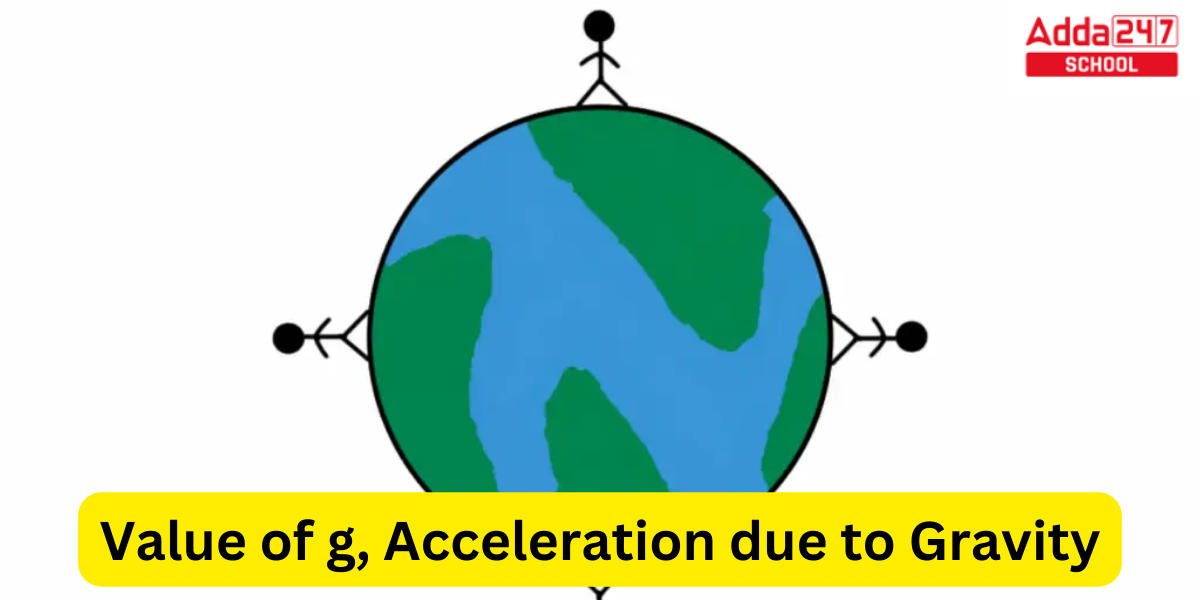Value of g
The term “acceleration due to gravity” refers to the force of gravity exerted by a massive body on a freely falling object, and it is denoted by the SI unit m/s2 value of g. The value of g changes from one body to another and is dependent on the mass and radius of the huge body.
The net acceleration that objects experience as a result of the combined action of gravity and centrifugal force as a result of the Earth’s rotation is known as Earth’s gravity, abbreviated as g. It is a vector quantity that has a plumb bob as its direction.
Acceleration due to Gravity (Value of g) of Earth
Earth’s acceleration caused by gravity, or the magnitude of g, is 9.8 m/s2. According to this, an object falling freely on Earth would accelerate by 9.8 metres per second. The gravity of the Earth is to blame for this acceleration.
Value of G- SI Unit of Acceleration due to Gravity
This acceleration is represented in newtons per kilogramme (N/kg or Nkg-1), which is equivalent to metres per second squared (m/s2 or ms2) in SI units. When air resistance is ignored, the acceleration of gravity near Earth’s surface is roughly 9.81 m/s2 (32.2 ft/s2), which means that the speed of an item falling freely will rise by 9.81 m (32.2 ft) per second per second. Sometimes this amount is jokingly referred to as tiny g.
Acceleration- Formula, Unit, Definition and Meaning
Acceleration due to Gravity (Value of g) of Heavenly bodies
Following table shows the Acceleration due to Gravity (Value of g) of the heavenly bodies of our Solar System:
| Planet/Heavenly Body | Radius(m) | Mass(Kg) | Value of g (m/s2) |
| Earth | 6.4 × 106 | 6 × 1024 | 9.8 |
| Mercury | 2.43 × 106 | 3.2 × 1023 | 3.61 |
| Venus | 6.073 × 106 | 4.88 × 1024 | 8.83 |
| Mars | 3.38 × 106 | 6.42 × 1023 | 3.75 |
| Jupiter | 6.98 × 107 | 1.901 × 1027 | 26.0 |
| Saturn | 5.82 × 107 | 5.68 × 1026 | 11.2 |
| Uranus | 2.35 × 107 | 8.68 × 1025 | 10.5 |
| Neptune | 2.27 × 107 | 1.03 × 1026 | 13.3 |
| Pluto | 1.15 × 106 | 1.2 × 1022 | 0.61 |
Value of g Formula
Acceleration due to gravity Formula is:
| g = GM/R2 |
Where,
- M is the mass of the heavy body measured in kg, and G is the universal gravitational constant, G = 6.674 × 10-11m3kg-1s-2.
- R is the enormous body’s radius as measured in m, and g is the acceleration brought on by gravity as measured in m/s2.
The Earth has a mass of 6 × 1024 kg.
Earth’s radius is 6.4 × 106 metres.
And G = 6.674 × 10-11m3kg-1s-2
When we substitute the values in the formula, we obtain:
g = (6.674 × 10-11m3kg-1s-2 6 × 1024 kg )/(6.4 × 106)2
| => g = 9.8 m/s2 |
Hence, g=9.8m/s2 is the value of g on Earth.
The unit of acceleration is followed by the acceleration caused by gravity.
I hope you now understand the definition, computation, SI units, table, and value of g for planets in the solar system along with acceleration due to gravity on Earth.
Drift Velocity, Definition and Formula
Precise Value of Acceleration due to Gravity (Value of g)
Depending on the location, the precise intensity of Earth’s gravity fluctuates. Standard gravity, the nominal “average” value at Earth’s surface, is by definition equal to 9.80665 m/s2 (32.1740 ft/s2). Several symbols are used to represent this amount, including gn, ge, g0, gee, and simply g. Nevertheless, ge can also refer to the Earth’s normal equatorial value of 9.78033 m/s2 (32.0877 ft/s2) (which is also used for the variable local value).
Variation in Magnitude of Acceleration due to Gravity (Value of g)
All places on the surface of a non-rotating perfect sphere with a uniform mass density or whose density varies only with distance from the centre (spherical symmetry) would experience a gravitational field of the same strength. The Earth rotates and is not spherically symmetric; rather, it is an oblate spheroid, which is flatter in the poles and bulges at the Equator. As a result, there are small variations in the strength of gravity on its surface.
Value of G Calculation Conventional Value of Acceleration due to Gravity
The standard gravitational acceleration for the Earth’s surface was established in 1901 by the third General Conference on Weights and Measures as gn = 9.80665 m/s2. It was based on measurements taken in 1888 near Paris at the Pavillon de Breteuil, with a theoretical correction made to convert to a latitude of 45 degrees at sea level. So, this definition is not a number for any specific location or a precisely calculated average, but rather an agreement to accept a value in the event that a better actual local value is unknown or unimportant. Moreover, it serves to specify the units of kilogramme and pound forces.
The acceleration of 9.8203 m/s2 is slightly higher than the standard gravity of 9.80665 m/s2 when the gravity at the surface of the Earth is calculated using the average radius of the planet (6,371 kilometres), the experimentally determined gravitational constant, and the mass of the planet (5.9722 × 1024 kg). The gravity on Earth at a radius of 6,375.4 km corresponds to the value of standard gravity.
Difference Between Plant cell and Animal cell for class 9 with Diagram
Difference between Nation and Country









 CUET UG Final Answer Key 2025 Revised, D...
CUET UG Final Answer Key 2025 Revised, D...
 DU Cut off 2025, Delhi University Expect...
DU Cut off 2025, Delhi University Expect...
 OUAT Result 2025 OUT @ouat.nic.in: Check...
OUAT Result 2025 OUT @ouat.nic.in: Check...









